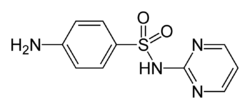Sulfadiazine
 |
|
 |
|
| Clinical data | |
|---|---|
| AHFS/Drugs.com | Monograph |
| MedlinePlus | a682130 |
| Pregnancy category |
|
| Routes of administration |
Topical cream, by mouth |
| ATC code | J01EC02 (WHO) QJ01EQ10 (WHO) |
| Legal status | |
| Legal status |
|
| Pharmacokinetic data | |
| Bioavailability | ? |
| Metabolism | ? |
| Biological half-life | ? |
| Excretion | ? |
| Identifiers | |
|
|
| CAS Number | 68-35-9 |
| PubChem (CID) | 5215 |
| DrugBank | DB00359 |
| ChemSpider | 5026 |
| UNII | 0N7609K889 |
| KEGG | D00587 |
| ChEMBL | CHEMBL439 |
| ECHA InfoCard | 100.000.623 |
| Chemical and physical data | |
| Formula | C10H10N4O2S |
| Molar mass | 250.278 g/mol |
| Melting point | 252 to 256 °C (486 to 493 °F) |
| |
|
Sulfadiazine is an antibiotic.[1] Used together with pyrimethamine it is the treat of choice for toxoplasmosis.[2] It is a second line treatment for otitis media, prevention of rheumatic fever, chancroid, chlamydia and infections by Haemophilus influenzae. It is taken by mouth.[1]
Common side effects include nausea, diarrhea, headache, fever, rash, depression, and pancreatitis.[1] It should not be used in people who have severe liver problems, kidney problems, or porphyria.[2] If used during pregnancy it may increase the risk of kernicterus in the baby.[1] It is believed to be safe during breastfeeding if the baby is otherwise healthy.[3] It is in the sulfonamide class of medications.[1]
Sulfadiazine was approved for medical use in the United States in 1941.[1] It is on the World Health Organization's List of Essential Medicines, the most important medications needed in a basic health system.[4] Sulfadiazine is available as a generic medication.[1] The wholesale cost in the developing world is about 2.70 to 7.32 USD a month.[5] In the United States treatment costs more than 200 USD a month.[6]
Medical uses[edit]
It eliminates bacteria that cause infections by stopping the production of folate inside the bacterial cell, and is commonly used to treat urinary tract infections, and burns.
In combination, sulfadiazine and pyrimethamine, can be used to treat toxoplasmosis, a disease caused by Toxoplasma gondii.
Mechanism of action[edit]
Sulfadiazine works by inhibiting the enzyme dihydropteroate synthetase. In combination with pyrimethamine (a dihydrofolate reductase inhibitor), sulfadiazine is used to treat active toxoplasmosis.
Side effects[edit]
Side effects reported for sulfadiazine include: nausea, upset stomach, loss of appetite, and dizziness.
Brand names[edit]
Lantrisul; Neotrizine; Sulfa-Triple #2; Sulfadiazine; Sulfaloid; Sulfonamides Duplex; Sulfose; Terfonyl; Triple Sulfa; Triple Sulfas; Triple Sulfoid
See also[edit]
References[edit]
- ^ a b c d e f g "Sulfadiazine". The American Society of Health-System Pharmacists. Retrieved 8 December 2016.
- ^ a b WHO Model Formulary 2008 (PDF). World Health Organization. 2009. pp. 126, 205. ISBN 9789241547659. Retrieved 8 December 2016.
- ^ "Sulfadiazine Use During Pregnancy | Drugs.com". www.drugs.com. Retrieved 9 December 2016.
- ^ "WHO Model List of EssentialMedicines" (PDF). World Health Organization. October 2013. Retrieved 22 April 2014.
- ^ "Sulfadiazine". International Drug Price Indicator Guide. Retrieved 8 December 2016.
- ^ Hamilton, Richart (2015). Tarascon Pocket Pharmacopoeia 2015 Deluxe Lab-Coat Edition. Jones & Bartlett Learning. p. 104. ISBN 9781284057560.